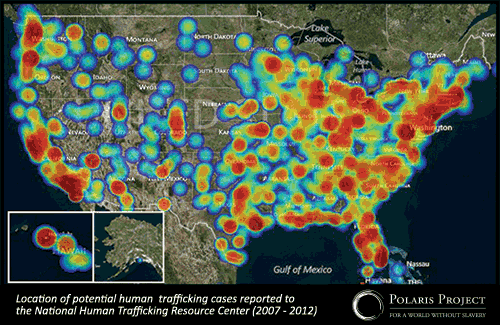How Many Years a Slave? by Karin Knox.
From the post:
Each year, human traffickers reap an estimated $32 billion in profits from the enslavement of 21 million people worldwide. And yet, for most of us, modern slavery remains invisible. Its victims, many of them living in the shadows of our own communities, pass by unnoticed. Polaris Project, which has been working to end modern slavery for over a decade, recently released a report on trafficking trends in the U.S. that draws on five years of its data. The conclusion? Modern slavery is rampant in our communities.
January is National Slavery and Human Trafficking Prevention Month, and President Obama has called upon “businesses, national and community organizations, faith-based groups, families, and all Americans to recognize the vital role we can play in ending all forms of slavery.” The Polaris Project report, Human Trafficking Trends in the United States, reveals insights into how anti-trafficking organizations can fight back against this global tragedy.
….
Bradley Myles, CEO of the Polaris Project, makes a compelling case for data analysis in the fight against human trafficking. The post has an interview with Bradley and a presentation he made as part of the Palantir Night Live series.
Using Palantir software, the Polaris Project is able to rapidly connect survivors with responders across the United States. Their use of the data analytics aspect of the software is also allowing the project to find common patterns and connections.
The Polaris Project is using modern technology to recreate a modern underground railroad but at the same time, appears to be building a modern data silo as well. Or as Bradley puts it in his Palantir presentation, every report is “…one more data point that we have….”
I’m sure that’s true and helpful, to a degree. But going beyond the survivors of human trafficking, to reach the sources of human trafficking, will require the integration of data sets across many domains and languages.
Police sex crime units have data points, federal (U.S.) prosecutors have data points, social welfare agencies have data points, foreign governments and NGOs have data points, all related to human trafficking. I don’t think anyone believes a uniform solution is possible across all those domains and interests.
One way to solve that data integration problem is to disregard data points from anyone unable or unwilling to use some declared common solution or format. I don’t recommend that one.
Another way to attempt to solve the data integration problem is to have endless meetings to derive a common format, while human trafficking continues unhindered by data integration. I don’t recommend that approach either.
What I would recommend is creating maps between data systems, declaring and identifying the implicit subjects that support those mappings, so that disparate data systems can both export and import shared data across systems. Imports and exports that are robust, verifiable and maintainable.
Topic maps anyone?
